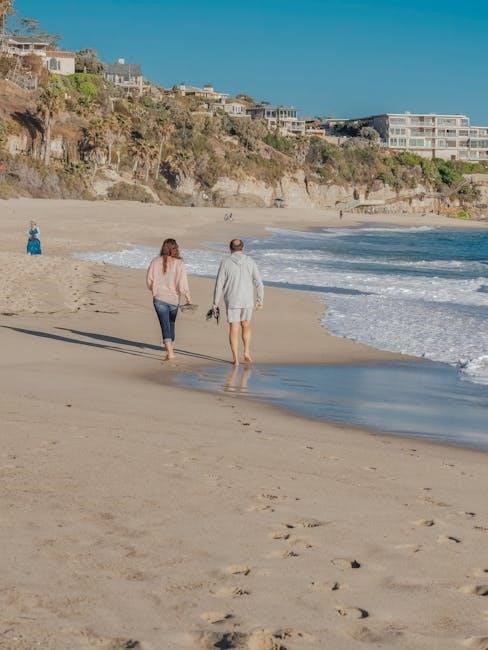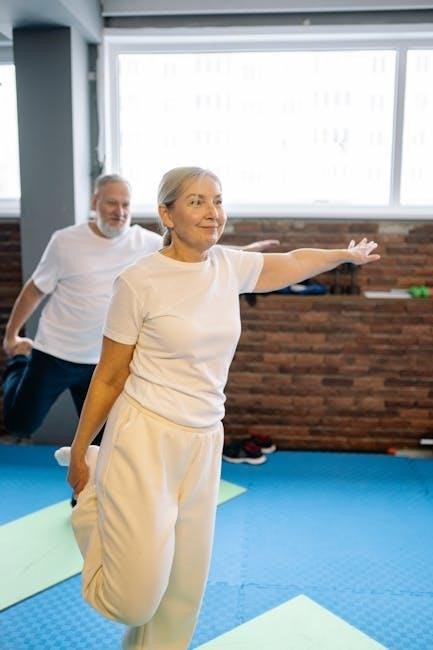Sciatica, a common condition in seniors, causes lower back and leg pain due to sciatic nerve irritation. Gentle exercises and stretches can improve mobility and reduce discomfort, enhancing quality of life for aging adults.
1.1 Understanding Sciatica and Its Causes
Sciatica refers to pain radiating along the sciatic nerve, often caused by herniated discs, spinal stenosis, or spondylolisthesis. It commonly affects seniors due to age-related spinal degeneration. Symptoms include lower back pain, numbness, and tingling in the legs. Understanding these causes is crucial for effective management and exercise planning to alleviate discomfort and improve mobility in older adults.
1.2 The Importance of Exercise for Managing Sciatica in Seniors
Exercise is crucial for managing sciatica in seniors, as it strengthens core and back muscles, improving spinal stability. Gentle movements enhance flexibility, reduce pain, and prevent further nerve irritation. Regular activity also boosts mobility and overall quality of life, making it easier for seniors to maintain independence and daily routines safely and effectively.
Benefits of Sciatica Exercises for Seniors
Sciatica exercises for seniors provide pain relief, improve mobility, and strengthen core muscles. They enhance flexibility, reduce stiffness, and promote overall well-being, making daily activities easier and safer.
2.1 Pain Relief and Improved Mobility
Sciatica exercises for seniors effectively alleviate pain and enhance mobility by targeting the sciatic nerve and surrounding muscles. Gentle stretches and low-impact movements improve flexibility, reduce stiffness, and restore range of motion, making daily activities easier and safer while promoting a better quality of life.
2.2 Strengthening Core and Lower Back Muscles
Strengthening the core and lower back muscles is essential for supporting the spine and alleviating sciatica symptoms. Gentle exercises like planks, bridges, and pelvic tilts help stabilize the spine, improving posture and reducing strain on the sciatic nerve, which can lead to long-term pain relief and prevention of future discomfort.
2.3 Enhancing Flexibility and Balance
Enhancing flexibility and balance through gentle exercises like hamstring stretches, hip flexor stretches, and tai chi can improve mobility and reduce sciatica-related discomfort. These exercises help maintain range of motion, prevent stiffness, and promote stability, making daily activities easier and less painful for seniors with sciatica.

Safe Sciatica Exercises for Seniors
Gentle stretching, low-impact aerobics, and strengthening exercises are safe for seniors with sciatica. These activities improve mobility without risking further injury, promoting long-term relief and stability.
3.1 Gentle Stretching Exercises
Gentle stretches, like the knee-to-chest and cat-cow stretches, are ideal for seniors with sciatica. These exercises improve flexibility, reduce stiffness, and alleviate pain without putting excessive strain on the body. They can be done seated or lying down, making them accessible for those with limited mobility. Regular practice enhances comfort and movement.
3.2 Low-Impact Aerobic Activities
Low-impact aerobics, such as swimming or water-based exercises, are excellent for seniors with sciatica. These activities strengthen muscles without stressing the back or legs. Short walking sessions also improve circulation and reduce stiffness. They are easy on the joints and promote overall well-being, making them ideal for managing sciatica comfortably.
3.3 Strengthening Exercises for Spinal Support
Strengthening exercises for spinal support, such as pelvic tilts and bridges, help stabilize the spine and reduce sciatica pain. These exercises target core and back muscles, improving posture and reducing nerve pressure. Gentle routines, like planks or bird-dog poses, can enhance spinal stability and promote long-term relief for seniors with sciatica.

Essential Stretches for Sciatica Relief
Essential stretches for sciatica relief focus on targeting tight muscles in the lower back, hips, and hamstrings. Gentle movements, such as cat-cow and knee-to-chest stretches, help alleviate pressure on the sciatic nerve, improving flexibility and reducing discomfort.
4.1 Knee to Chest Stretch
The knee-to-chest stretch targets the lower back and hips, relieving sciatic nerve pressure; Lie on your back, bring one knee toward your chest, and hold for 20-30 seconds. Breathe deeply, then slowly lower your leg. Repeat on the other side. This gentle stretch improves flexibility and reduces discomfort, ideal for seniors with sciatica.
4.2 Cat-Cow Stretch
The Cat-Cow stretch gently warms up the spine, improving flexibility and relieving sciatic tension. Start on hands and knees. Arch your back, lifting your head (Cow Pose), then round your spine, tucking your chin (Cat Pose). Repeat slowly, syncing breath with movement, for 5-10 repetitions. This stretch enhances spinal mobility and reduces stiffness in seniors.
4.3 Hamstring and Hip Flexor Stretches
Hamstring and hip flexor stretches reduce sciatic nerve tension and improve flexibility. Sit on the floor with legs extended or stand and lift one leg backward. Hold for 20-30 seconds, then switch sides. These stretches promote better posture, reduce lower back strain, and alleviate sciatica-related discomfort, especially beneficial for seniors with limited mobility.

Exercise Safety and Precautions
Seniors should consult healthcare providers before starting sciatica exercises. Avoid high-impact activities and listen to your body to prevent worsening pain or injury.
5.1 Consulting a Healthcare Provider
Before starting sciatica exercises, seniors should consult a healthcare provider to assess their physical condition and ensure safety. A professional can tailor exercises to individual needs, monitor progress, and prevent aggravating symptoms, ensuring a safe and effective routine.
5.2 Avoiding High-Impact Activities
High-impact activities can exacerbate sciatica symptoms in seniors by placing excessive stress on the spine and joints. It’s crucial to avoid running, jumping, or heavy lifting. Opting for low-impact exercises like swimming or walking helps maintain mobility without aggravating the condition, promoting safer and more effective pain management.
5.3 Listening to Your Body
Seniors must pay attention to their physical sensations during exercises. If pain worsens, stop immediately and consult a healthcare provider. Honor your body’s limits to avoid further injury. Rest when needed, and gradually increase activity levels to ensure safe and effective progress in managing sciatica symptoms.

Modifying Exercises for Seniors with Mobility Issues
Modify exercises to accommodate physical limitations, using chairs or assistive devices for support. Focus on seated or gentle movements to ensure safety and comfort while managing sciatica.
6.1 Chair-Based Exercises
Chair-based exercises are ideal for seniors with limited mobility, offering gentle stretches and strengthening movements while seated. These exercises improve flexibility, reduce stiffness, and can be modified to suit individual abilities. They often include seated stretches, pelvic tilts, and controlled breathing techniques to enhance comfort and manage sciatica-related discomfort effectively.
6.2 Using Assistive Devices
Assistive devices like canes, walkers, and back supports enhance safety and stability during exercises. They reduce strain on the lower back, allowing seniors to perform movements with confidence. These tools promote independence and help manage sciatica symptoms, making exercises more accessible and effective for those with limited mobility or strength.
6.3 Breathing Techniques for Pain Management
Diaphragmatic breathing and relaxation exercises help manage sciatica pain by reducing tension and promoting blood flow. These techniques, often combined with gentle stretches, can alleviate discomfort and improve overall well-being for seniors. Proper breathing enhances exercise effectiveness and supports long-term pain relief, making it a valuable tool in sciatica management routines.
Role of Breathing and Relaxation in Sciatica Management
Breathing techniques, like diaphragmatic breathing, help reduce sciatica-related tension and discomfort. Relaxation practices, such as progressive muscle relaxation, complement exercises by enhancing pain relief and overall well-being in seniors.
7.1 Diaphragmatic Breathing
Diaphragmatic breathing engages the diaphragm, promoting deep relaxation and reducing muscle tension. This technique helps alleviate sciatica pain by improving oxygen flow and calming the nervous system, making it an essential practice for seniors managing sciatica discomfort effectively and naturally.
7.2 Progressive Muscle Relaxation
Progressive Muscle Relaxation involves tensing and relaxing muscle groups to reduce tension. For seniors with sciatica, this technique can ease pain and muscle tightness, promoting relaxation. It complements exercises by reducing stress and anxiety, enhancing overall well-being and making it easier to manage sciatica symptoms effectively.
7.3 Mind-Body Exercises
Mind-body exercises like yoga and tai chi combine physical movement with deep breathing and mental focus. These practices improve flexibility, balance, and strength while reducing sciatica-related stress and anxiety. They promote relaxation and can be adapted to suit seniors’ mobility levels, enhancing both physical and emotional well-being.
Creating a Daily Exercise Routine
Establishing a consistent routine helps seniors manage sciatica effectively. Start with short sessions, gradually increasing duration. Include gentle stretches, strengthening exercises, and finish with relaxation techniques for optimal relief and mobility.
8.1 Setting Realistic Goals
Setting realistic goals is crucial for seniors starting a sciatica exercise routine. Begin with achievable objectives, like 10-minute daily sessions, and gradually increase duration and intensity. Celebrate small milestones to stay motivated and ensure sustainable progress in managing sciatica symptoms effectively over time.
8.2 Incorporating Warm-Up and Cool-Down Routines
Incorporating warm-up and cool-down routines helps seniors prepare for sciatica exercises, preventing injuries and improving flexibility. Gentle stretches, light movements, and deep breathing exercises are ideal for warming up. Cooling down with static stretches and relaxation techniques ensures a safe transition, promoting muscle recovery and reducing post-exercise discomfort effectively.
8.3 Tracking Progress and Staying Motivated
Tracking progress through journals or mobile apps helps seniors monitor improvements in mobility and pain relief. Celebrating small milestones boosts motivation. Sharing achievements with healthcare providers or support groups enhances accountability and encouragement, keeping seniors committed to their sciatica exercise routines for long-term benefits and overall well-being.
Resources and Guides for Sciatica Exercises
Access printable PDF guides, video tutorials, and mobile apps for structured routines. These resources provide clear instructions and demonstrations, helping seniors safely perform exercises tailored to their needs.
9.1 Printable PDF Guides
Printable PDF guides offer structured routines with step-by-step instructions and visuals. Seniors can access exercises tailored to their needs, ensuring safety and effectiveness. These guides are easy to follow, printable, and shareable, making them a valuable resource for managing sciatica comfortably at home.
9.2 Video Tutorials and Demonstrations
Video tutorials provide visual guidance, helping seniors perform exercises correctly. Demonstrations by professionals ensure proper form, reducing injury risk. These videos often include modifications for mobility issues, making them accessible and effective for managing sciatica symptoms and improving overall well-being.
9.3 Mobile Apps for Exercise Tracking
Mobile apps offer personalized exercise plans, reminders, and tracking features. They allow seniors to monitor progress, set goals, and access instructional videos. These tools promote consistency and motivation, helping users stay committed to their sciatica management and overall fitness journey with ease and convenience.
Success Stories and Testimonials
Many seniors have found significant relief from sciatica pain through targeted exercises. Real-life testimonials highlight improved mobility and reduced discomfort, encouraging others to embrace these beneficial routines.
10.1 Seniors Who Benefited from Sciatica Exercises
Seniors who consistently practiced sciatica exercises reported reduced pain and improved mobility. Many shared their success stories, highlighting how these routines enhanced their daily activities and overall quality of life, serving as inspiration for others to adopt similar practices for managing sciatica effectively.
10.2 Real-Life Experiences
Real-life experiences highlight seniors overcoming sciatica challenges through targeted exercises. Many found relief by incorporating gentle stretches and strengthening routines, which not only reduced pain but also restored their ability to perform daily tasks with greater ease and confidence, showcasing the positive impact of consistent practice on their well-being.
10.3 Encouragement for Starting the Journey
Embrace the journey to sciatica relief with confidence. Seniors who begin with small, consistent efforts often find significant improvements in pain and mobility. Celebrate each milestone, no matter how small, and remember that every step toward a healthier lifestyle is a victory worth acknowledging and building upon.
Sciatica exercises for seniors offer effective relief and improved mobility. Consistency is key; consult professionals for personalized plans and explore resources for ongoing support and guidance.
11.1 Summary of Key Points
Sciatica exercises for seniors are essential for pain relief and mobility. Gentle stretches, core strengthening, and low-impact activities are recommended. Consult healthcare professionals, avoid high-impact exercises, and use assistive devices if needed. Regular practice enhances flexibility and balance, improving overall well-being and reducing discomfort effectively for aging adults.
11.2 Encouraging Ongoing Practice
Consistency is key to managing sciatica. Seniors should establish a daily routine, track progress, and celebrate small achievements. Using resources like PDF guides and video tutorials can maintain engagement. Support from family and healthcare providers also fosters motivation, ensuring long-term adherence to beneficial exercise practices for sustained relief and improved mobility.
11.3 Final Tips for Long-Term Relief
For lasting sciatica relief, seniors should focus on gentle exercises, proper posture, and regular physical activity. Incorporating low-impact aerobics and strength training supports spinal health. Consulting healthcare providers ensures personalized plans, while adherence to routines and lifestyle adjustments promotes sustained comfort and mobility, enhancing overall well-being and independence in daily life effectively.
Additional Resources and References
Access printable PDF guides, video tutorials, and mobile apps for tracking sciatica exercises. These resources provide comprehensive support for seniors to manage sciatica effectively and safely.
12.1 Recommended Websites
Visit trusted websites like Hospital for Special Surgery, NHS, and Physiotherapy Exercises for detailed guides on sciatica exercises for seniors. These sites offer video tutorials, downloadable PDFs, and expert tips to help manage sciatica effectively and safely at home.
12.2 Books and eBooks
Explore books like “Sciatica Relief and Exercise Guide” and “Healing Sciatica Naturally” for comprehensive exercise plans tailored for seniors. These resources offer step-by-step instructions, illustrations, and expert advice to safely manage sciatica symptoms and improve mobility through targeted exercises and lifestyle adjustments.
12.3 Professional Consultations
Consulting with physical therapists or healthcare providers ensures personalized exercise plans for seniors with sciatica. Professionals offer tailored guidance, addressing specific needs and mobility levels, to maximize the effectiveness of exercises and promote long-term relief from sciatica symptoms safely and efficiently.